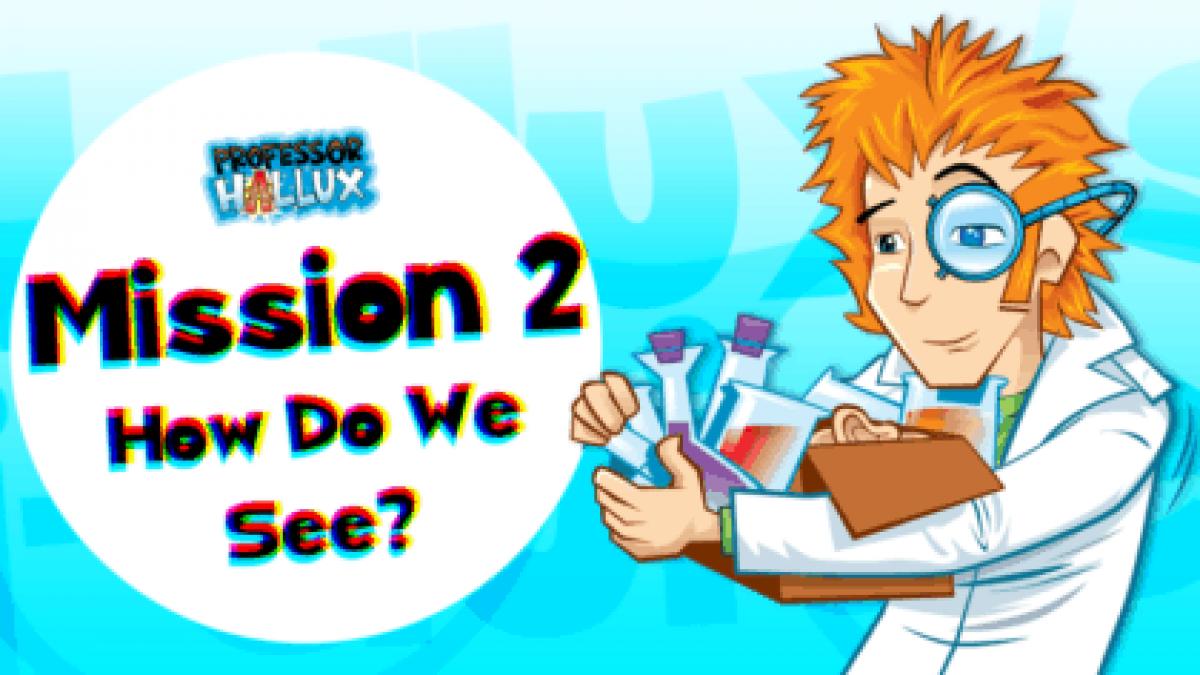Who is Professor Hallux?
Professor Hallux is a scientist who is really curious about everything to do with the human body!
With the help of Nurse Nanobot he wants to find out everything he can about how the human body works.

Watch this video in which Professor Hallux and Nurse Nanobot find out how we see…
After that you should have a good idea of how we use our eyes to see the world around us.
What is the most important thing we need to be able to see (except for eyes)?
Light!
Without light you can’t see anything and your eyes would be useless.
Let’s test that, if you close your eyes then you can’t see anything! That’s because no light can get into your eyes so your eyes are not able to see anything.
How does light actually help us see?
Light bounces off everything around you – it could be from the sun or a light bulb or anything that produces light – and goes into your eyes.
Your eyes then make sense of all that light that goes into them and makes the images that you can see in your brain.
Does my eye control how much light is getting in it?
Yes! Remember that the pupil is the black hole in the middle of your eye and the iris makes the hole bigger and smaller.

The pupil hole will go small if there’s lots of light (as too much light can damage the eye), and will go big if there’s not much light around so that it can let in as much as possible so that you can see everything around you.

What happens once the light is in my eye?
Well first it goes through the lens.

The lens makes sure that the light coming through your eye is in focus.
When the light is not in focus then everything will seem blurry and fuzzy.
My friend says he sees everything blurry when he’s not wearing his glasses, is there something wrong with his lens?
Your friend’s lens isn’t working as well as it should be so that’s why he sees things as being all fuzzy – because his lens isn’t focusing the light like it should be.
His glasses bend the light in a special way that corrects the problem and lets him see things normally and in focus.

What happens to the focused light once it’s in the eye?
This focused light hits the retina at the back of the eye and this is where all the information about the light is collected!

How does the retina make sense of the light that hits it?
The retina uses very special cells to process the light.
These cells are called rods and cones.

You have 120 million rods and 7 million cones in each eye!
How do the rods and cones work?
Rods

Rods detect light waves for black, white and grey and tell us the form or shape that something has.
Rods are super sensitive so that we can see even when it’s very dark.
Cones

The cones sense colour and they are not as sensitive as the rods so they need more light to work well.
There are 3 types of cones and each one is sensitive to one of these colours: red, green and blue.
Together they can sense combinations of light waves that let us see millions of different colours!
So the cells have detected the shapes and colours of the things around us, how does this information get to the brain?
Through the optic nerve.

This is a connection between the eye and the brain. Once the cells in the eye have this information they send it through the optic nerve to the brain.
The brain then takes all this information and makes pictures from it and that’s what we see when we look at things.
Your mission is to do an eye experiment!
You know loads about how the eyes let you see but let’s put some of that to the test!
We talked about how your pupils will get smaller when there’s lots of light and bigger when it’s dark – let’s test that.
Get someone to help you – your brother, sister, mum, dad, or whoever you can find.
Get them to stand in a dark room with the lights off. Watch their pupils carefully and you should see they are quite big in the dark.
Then, make sure you keep watching their pupils while you do this, turn on the lights and you should see their pupils change in size to adjust to all the light!
Click here to see the next mission all about how glasses work!
If you want more from professor Hallux then you can find more here.
Add a commentWeek 5: Eyes
This week's missions are all to do with your eyes and how they work! We'll be finding out all about eyes with the help of Professor Hallux and Nurse Nanobot!
More From Week 5: Eyes






